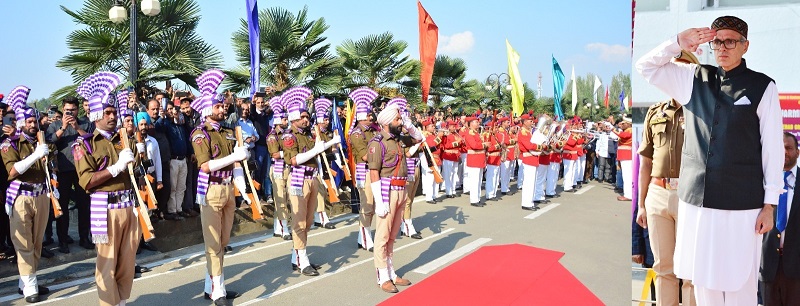
The National Conference has regained its dominant role in Kashmir politics by securing 42 seats, or 46 when including the independents who joined. However, the number falls way short of the 57 seats the party secured in 1996 giving it an absolute majority in J&K, which enabled it to pass an autonomy resolution in 1999. This time, the mandate is largely Valley-centric and the context too has transformed beyond recognition. J&K has now been divested of its special constitutional status and downgraded into two union territories – J&K and Ladakh. The elected government thus has fewer powers and more or less a ceremonial value. But it still has a profound significance. For the party pulled off this victory amid a crowded electoral scene which seemed set to splinter the Valley’s mandate.
At one point in the election, the Awami Ittehad party (AIP), seemed set to replicate its parliamentary party performance where its jailed leader Engineer Rashid won by a whopping 4,52,812 votes – two-thirds of the total – defeating political heavyweights such as former Jammu and Kashmir chief Omar Abdullah and Sajad Lone. This gave AIP a majority across almost 12 of the 15 Assembly segments in North Kashmir. But this time the party could barely win one seat, that too despite Rashid being released from Tihar to campaign for his party.
The banned separatist outfit Jamaat-i-Islami met the same fate: Not one of the independent candidates fielded by the party won. Similarly, the parties like Altaf Bukhari’s Apni Party and Ghulam Nabi Azad’s DPAP, both formed in the past five years, failed to win a single seat, while the People’s Conference (PC) led by Sajad Lone only secured his own seat.
How did this happen? How could a critical mass of Kashmiris by and large collectively vote for a single party in a jam-packed electoral arena without being distracted by almost similar sounding rhetoric, agenda and manifestos? There are complex factors at play here but what stands out is a longstanding truth of Kashmir politics: the parties need to maintain a safe distance from New Delhi when they conduct their local politics. The moment they are seen close to a ruling party in New Delhi and, in other words, aligned with its agenda, they become alien to Kashmir. And rightly so: their fundamental job is to represent Kashmir to New Delhi and not the vice versa. This has become more relevant when the centre’s bonafides have become more suspect in the Valley. Not that the NC doesn’t straddle the divide but in the absence of a credible challenge from the PDP hobbled by the baggage from its alliance with the BJP, Abdullahs were seen most Kashmir-centric in their politics
That said, the constraints for the new government can’t be underestimated. Omar’s conciliatory tone towards the BJP reflected the NC-Congress alliance’s formidable challenges in the union territory. He wouldn’t be just dealing with the BJP government at the centre and its powerful Lieutenant Governor in J&K but he will also be up against the BJP as a regional opposition party with the second largest number of seats. The saffron party increased its tally in the Jammu division from the 25 seats in 2014 to 29 now, making it the majority party from the Hindu-dominated region.
Despite the confusion created by an electoral scene populated by diverse political entities and independent candidates, people in the Valley largely rallied around the NC, seeing in the NC-Congress alliance the best guarantee for the protection of their rights. On the other hand, the voters in Jammu, particularly in its Hindu-dominated areas, consolidated in favour of the BJP. The situation now is that both the regions have chosen ideologically divergent parties to represent them. While the NC-Congress alliance has won a majority of seats, the BJP, on its own, and even with the support of its purported allies in the Valley can’t secure the majority.
This makes the NC-Congress coalition amenable to accusations of leaving out Jammu region from any credible representation in the new elected government. Already such voices have reared their head in Jammu. Social media in Jammu is abuzz with the people expressing resentment at being left out of the government, even after consolidating in favour of the BJP.
Going forward, the new government will need to perform a tight balancing act to survive. With the BJP controlling the Union government and the LG wielding considerable authority in the Union Territory, the NC-Congress coalition will have a tough time asserting its power, if any. The coalition has over 50 seats between them which makes for a secure majority. The BJP which was hoping to form a government by roping in the smaller parties and the independents from Kashmir Valley doesn’t have many options. And for now, the party could settle for a role in the opposition but it would be there to make the most of every opportunity to highlight the failure of the NC-Congress coalition.
- Views expressed in the article are the author’s own and do not necessarily represent the editorial stance of Kashmir Observer
Follow this link to join our WhatsApp group: Join Now
Be Part of Quality Journalism |
Quality journalism takes a lot of time, money and hard work to produce and despite all the hardships we still do it. Our reporters and editors are working overtime in Kashmir and beyond to cover what you care about, break big stories, and expose injustices that can change lives. Today more people are reading Kashmir Observer than ever, but only a handful are paying while advertising revenues are falling fast. |
| ACT NOW |
| MONTHLY | Rs 100 | |
| YEARLY | Rs 1000 | |
| LIFETIME | Rs 10000 | |













